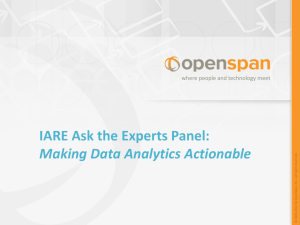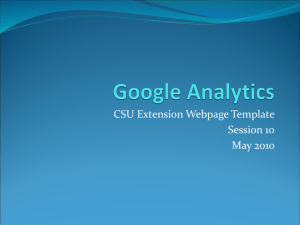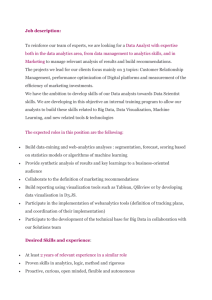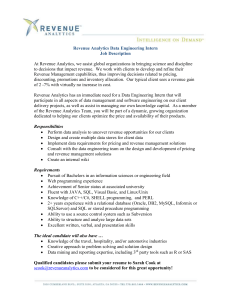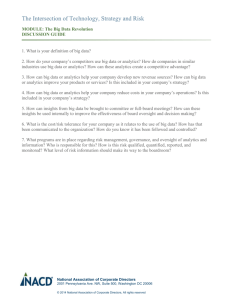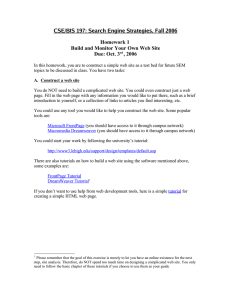Methods and Models in Business Analytics
advertisement
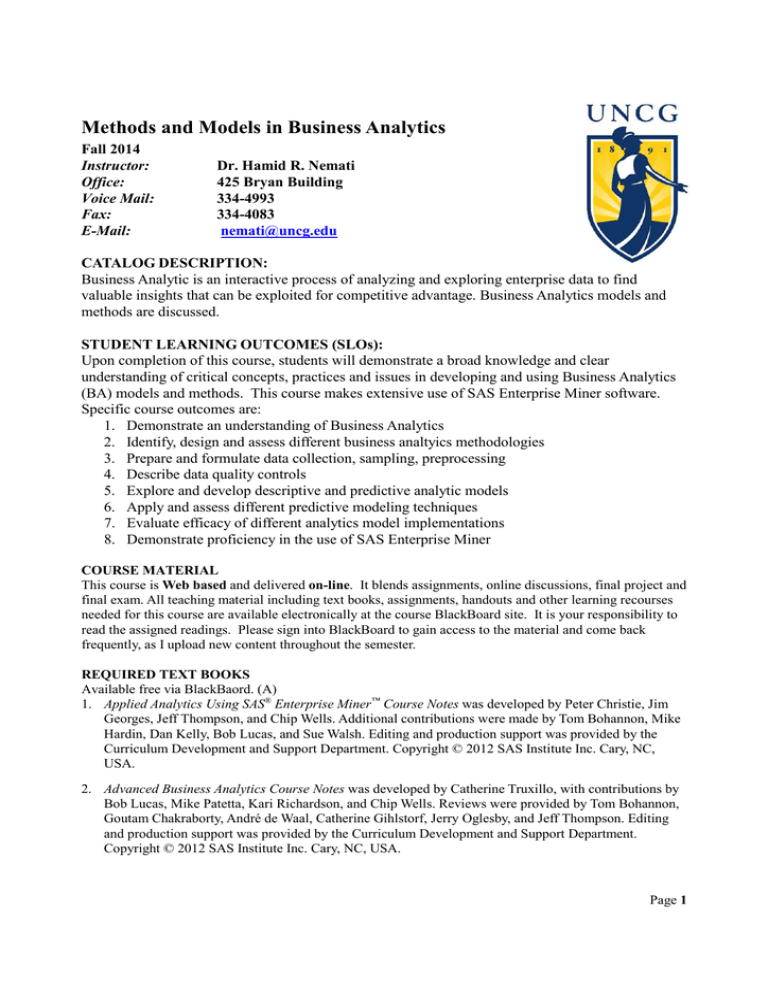
Methods and Models in Business Analytics Fall 2014 Instructor: Office: Voice Mail: Fax: E-Mail: Dr. Hamid R. Nemati 425 Bryan Building 334-4993 334-4083 nemati@uncg.edu CATALOG DESCRIPTION: Business Analytic is an interactive process of analyzing and exploring enterprise data to find valuable insights that can be exploited for competitive advantage. Business Analytics models and methods are discussed. STUDENT LEARNING OUTCOMES (SLOs): Upon completion of this course, students will demonstrate a broad knowledge and clear understanding of critical concepts, practices and issues in developing and using Business Analytics (BA) models and methods. This course makes extensive use of SAS Enterprise Miner software. Specific course outcomes are: 1. Demonstrate an understanding of Business Analytics 2. Identify, design and assess different business analtyics methodologies 3. Prepare and formulate data collection, sampling, preprocessing 4. Describe data quality controls 5. Explore and develop descriptive and predictive analytic models 6. Apply and assess different predictive modeling techniques 7. Evaluate efficacy of different analytics model implementations 8. Demonstrate proficiency in the use of SAS Enterprise Miner COURSE MATERIAL This course is Web based and delivered on-line. It blends assignments, online discussions, final project and final exam. All teaching material including text books, assignments, handouts and other learning recourses needed for this course are available electronically at the course BlackBoard site. It is your responsibility to read the assigned readings. Please sign into BlackBoard to gain access to the material and come back frequently, as I upload new content throughout the semester. REQUIRED TEXT BOOKS Available free via BlackBaord. (A) 1. Applied Analytics Using SAS® Enterprise Miner™ Course Notes was developed by Peter Christie, Jim Georges, Jeff Thompson, and Chip Wells. Additional contributions were made by Tom Bohannon, Mike Hardin, Dan Kelly, Bob Lucas, and Sue Walsh. Editing and production support was provided by the Curriculum Development and Support Department. Copyright © 2012 SAS Institute Inc. Cary, NC, USA. 2. Advanced Business Analytics Course Notes was developed by Catherine Truxillo, with contributions by Bob Lucas, Mike Patetta, Kari Richardson, and Chip Wells. Reviews were provided by Tom Bohannon, Goutam Chakraborty, André de Waal, Catherine Gihlstorf, Jerry Oglesby, and Jeff Thompson. Editing and production support was provided by the Curriculum Development and Support Department. Copyright © 2012 SAS Institute Inc. Cary, NC, USA. Page 1 RECOMMENDED TEXT BOOKS 1. Keeping Up with the Quants: Your Guide to Understanding and Using Analytics. By Thomas H. Davenport and Jinho Kim, Harvard Business Review Press, ISBN-13: 978-1422187258. (Q) 2. Predictive Analytics: The Power to Predict Who Will Click, Buy, Lie, or Die, By Eric Siegel, Wiley Press, ISBN-13: 978-1118356852. (P) SOFTWARE NEEDED FOR THE COURSE: This course makes extensive use of SAS® Enterprise Miner™ 13.2. You will have two options to access this software. The instruction for getting access to the software will be distributed to the students in the first week of class and will be available via course BlackBoard. 1. Option 1: You can get your own personal copy of SAS and SAS® Enterprise Miner™ and install it on your laptop. The instruction for getting your personal copy is on BlackBoard. You need to do this during the first couple of weeks of the semester. SAS® Enterprise Miner™ is part of SAS 9.4. This software is VERY expensive and powerful. You will need it for your ISM 685 as well so having your own personal copy is a good thing. 2. Option 2: You can use SAS Cloud based version of software. Instructions as how to do that are also on Blackboard. SOFTWARE IMPLEMENTATION ASSIGNMENTS you will have three topical assignments each one dealing with specific tools available in SAS® Enterprise Miner™. Assignments are due on the date/time specified in the course. Assignments turned in late will be assessed a grading penalty. Assignments submitted after the due date may not be accepted but, if they are based on valid excuse, there will be a minimum of a 20% reduction for each day late. Also, any assignment that requires rework will be assessed at least 20% penalty. 1. Assignment 1 deals with data collection, sampling, preprocessing and quality control descriptive model development. 2. Assignment 2 deals with predictive model development and assessment and implementation. 3. Assignment 3 deals with clustering and market basket analysis model development and assessment and implementation. FINAL PROJECT AND REPORT You must join a group of NOT MORE THAN 4 to develop a final research proposal and a final report on a topic of approved by the instructor. This project topic must be related to one or more aspect(s) of Business Analytics as discussed in the course, where you will be developing and/or examining the impact of BA methods and models in a business environment. This project will have two parts. The first part is a report where you propose and describe your final project topic, its importance and a proposed methodology. The second part is the actual project implementation and write up. I will describe this project further as we go along in the course. FINAL EXAM A timed on line final exam is required for the course. The exam will test your knowledge of business analytics topics and the use of software. CLASS DISCUSSION BOARD AND PARTICIPATION IN COLLABORATE SESSIONS Each student is required to regularly discuss online with the instructor on project progress. EVALUATION AND GRADING: The course will be letter graded. A student’s final grade will depend on the quality of the project components. ISM 675: Methods and Models Business Analytics 2| Contribution to class discussion board and Participation in collaborate sessions 5% Assignments (1 @ 10% and 2 @ 15% each) 40% Final Project and Report 30% Final Exams 25% Total 100% Letter Grades and Points 950-1000 = A, 900-940 = A-, 860-890 = B+, 830-850 = B, 800-820 = B-, 760-790 = C+, 730-750 = C, 700720 = C-, 690 and below =F ATTENDANCE POLICY: Since it is an online class, no physical class-room attendance is required. It is the student’s responsibility to stay on track with readings and assignments to be successful in the course. NETIQUETTE: The same guidelines that apply to traditional classes should be observed in the virtual classroom environment. Please use proper netiquette when interacting with class members and the professor. POLICY ON SERVER UNAVAILABILITY OR OTHER TECHNICAL DIFFICULTIES The university is committed to providing a reliable online course system to all users. However, in the event of any unexpected server outage or any unusual technical difficulty which prevents students from completing a time sensitive assessment activity, the instructor will extend the time windows and provide ELECTRONIC MAIL AND BLACKBOARD (BB) ACCOUNTS: You should check your UNCG email and BB Course link regularly as I may send email updates or add new info on BB on an ongoing basis. You will be responsible for any information or announcements contained in the email messages or updates on BB. ACADEMIC INTEGRITY, ETHICAL ISSUES AND THE HONOR CODE POLICIES: Students are responsible for becoming familiar with the Academic Integrity Policy in all its aspects and for indicating their knowledge and acceptance of the Policy by signing the Academic Integrity pledge on all major work submitted for the course. All individual assignments must be done by only you. Individuals should not work on assignments together. A single failure to follow this policy will result in a grade of 0 on that assignment; subsequent violations of this policy will result in a grade of F for the course. University students are expected to conduct themselves in accordance with the highest standards of academic honesty. Academic misconduct for which a student is subject to penalty includes all forms of cheating, such illicit possession of examinations or examination materials, forgery, or plagiarism. Students will NOT make, borrow, or "share" copies of their assignments or files with other students. Plagiarism is defined as "presenting as one’s own work that work which is, in whole or in part, the work of another person or persons without giving proper credit to the appropriate source." This includes submitting work done by another, as one’s own work. It is understood that what you turn in to me for grade represents your own effort. Plagiarism will be immediately punished with a grade of zero for the assignment in question. Further disciplinary action will be pursued as I deem appropriate. Helping one another is allowed, but copying is cheating. This practice is against the UNCG Honor Code and defeats the purpose of this course. No credit will be received for shared work, and other penalties may be imposed. I will pursue cheating as far as the university allows me. Specific information on the Academic Integrity Policy may be found on the UNCG web site at http://academicintegrity.uncg.edu ISM 675: Methods and Models Business Analytics 3 Course Outline This schedule is tentative and changes may be required during the course of the semester. EM refers to: Applied Analytics Using SAS® Enterprise Miner™ AEM refers to: Advanced Business Analytics Week of Aug 18th and Aug 25th Introduction to the Course Introduction to Business Analytics Introduction to Descriptive Analytics Introduction to Predictive Analytics EM Chapters 1, 2 AEM Chapters 1 Week of Sept 1st Descriptive Analytics Modeling Data, Data, Data Everywhere Explore SAS Enterprise Miner Accessing and Assaying Prepared Data EM Chapters 1, 2 AEM Chapter 2 Week of Sept. 8th Predictive Analytics Modeling Final Project Part 1 Due on Sept 8th at midnight. EM Chapters 1, 2, 3 AEM Chapter 4 Week of Sept 15th Predictive Analytics Modeling using Decision Trees EM Chapters 1, 2, 3 AEM Chapter 4 Week of Sept. 22nd Predictive Analytics Modeling using Regressions EM Assignment 1 Due on Mon. Sept 22nd at midnight. EM Chapter 4 AEM Chapter 4 Week of Sept. 29th Predictive Analytics Modeling using Neural Networks and Other Modeling Tools EM Chapter 5 AEM Chapter 4 Week of Oct 6th Introduction to BIG DATA Analytics Get ready for your final project Review EM Chapters 1-5 Articles Week of Oct 13th Fall Break Week of Oct 20th Predictive Analytics Model Assessment EM Chapter 6 AEM Chapter 5 Week of Oct 27th Introduction to Cluster Analysis EM Chapter 8 ISM 675: Methods and Models Business Analytics 4| AEM Chapter 6 Articles EM Assignment 2 Due on Mon. Oct 27th at midnight Week of Nov 3th Market Basket Analysis EM Chapter 8 AEM Chapter 6 Articles Week of Nov 10th Model Implementation Business Analytics Organizational and Managerial Issues Business Analytics Privacy and Ethical Issues EM Assignment 3 Due on Mon. Nov. 10th at midnight Weeks of Nov. 17Dec. 1 Work on Final Projects/ Prepare for Final Exam Final Project Due on Nov. 24th at midnight. Final Exam Due on Dec. 1rd at midnight. ISM 675: Methods and Models Business Analytics 5
